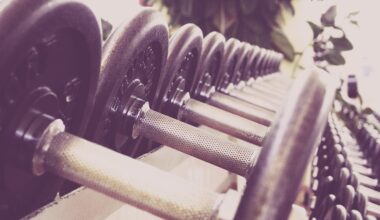Daily Dance Drills to Increase Hip Mobility
Incorporating daily dance drills into your routine can significantly enhance your hip mobility. Understanding the connection between hip flexibility and dance is essential for performers wanting to improve their range of motion. Regular practice not only promotes flexibility but also aids in preventing injuries. Start with simple warm-ups such as leg swings and hip circles that gently prepare the body. Stretching exercises like the butterfly stretch can be beneficial. These should be done consistently to maintain a good level of flexibility. Additionally, keeping a journal to track progress may encourage commitment. Including drills and sets that target specific muscle groups around the hips will yield better results. For example, practicing lunges and side leg lifts can increase control and stability. Another aspect to integrate is engaging in foam rolling to release tight muscles. The right technique can enhance overall functionality and mobility. Keeping your movements fluid and controlled during practice is vital for efficiency. Consider joining online dance classes focused on flexibility. Ultimately, dedication and consistency lead to noticeable improvements in hip mobility.
Another exciting drill to incorporate is the grand plié. This classic movement engages multiple muscle groups while opening the hips. By practicing it regularly, you’ll notice an increased ability to descend deeper into the plié, which enhances overall hip flexibility. Start from a comfortable distance and slowly lower yourself. Ensure you maintain your back straight and core engaged to avoid injury. Additionally, consider incorporating dynamic stretching such as leg swings while seated, which can help in further loosening up tight hips. Engaging in yoga can also complement your dance drills by emphasizing flexibility and mobility. Poses like pigeon pose and lizard pose stretch hip flexors effectively. Another helpful element is the use of resistance bands; they are fantastic for muscle activation. Use them to perform lateral band walks to strengthen the glute and hip muscles. Focusing on controlled breathing while performing these exercises can improve endurance and prevent strain. Practicing these drills daily keeps the hips responsive and ready for various dance movements. A gradual increase in the complexity of the drills is important for long-term development. Always listen to your body to optimize your workload.
Building a Routine
Establishing a structured daily routine for hip mobility can create a rhythm essential for progress. Start by dedicating a specific time each day to practice these drills. Consistency is key; this means setting aside at least 20 to 30 minutes for these exercises. This dedicated time enables the body to adapt and improve efficiently over time. Another beneficial approach is to combine cardiovascular workouts with mobility exercises. Activities such as jogging or cycling warm up the body, making it more pliable for dance drills. Pairing this with hip-specific drills like squats or deep lunges can enhance overall mobility. Tracking your daily progress in flexibility can also provide motivation. Consider using an app designed for fitness tracking to help maintain accountability. Furthermore, engaging in gentle dance styles such as salsa might promote fluidity through the hips. The rhythmic movements can massage and strengthen the muscles. Another option is to join a dance group focused on mobility. Social aspects often motivate individuals to stick with their routines. Lastly, take time to reflect on your progress, adjusting your daily drills accordingly.
For added fun and variety, consider incorporating music into your daily dance drills. Music brings a rhythmic element that inspires movement and promotes creativity. Choose tracks with varying tempos to challenge yourself with different speeds and styles. Experimenting with various dance genres, such as jazz or contemporary, can provide new angles for hip mobility work. It keeps the mind engaged and excited about the practice. As you progress, aim to increase the complexity of the drills by introducing combinations and transitions. These actions should mimic real dance routines to boost competence and confidence. Regular practice with goals can enhance technique significantly. Another option is to find a dance partner for drills. Practicing with someone can turn individual sessions into enjoyable social events, reinforcing commitment. Consider also sharing your journey on social media platforms. Engaging with an online community can provide support and inspiration. Additionally, try incorporating elements of freestyle dancing into your routine. This spontaneous movement often encourages natural flexibility through unplanned patterns. Never shy away from exploring different styles, as they may provide valuable insight into your body’s capabilities.
Preventing Injury
With any physical activity, injury prevention is crucial, especially when focusing on hip mobility. Always start with a proper warm-up routine, as this prepares your muscles for upcoming movements and minimizes the risk of tears. Additionally, integrating cooling down and stretching at the end of each session keeps muscles from tensing up. Always listen to your body and avoid pushing beyond its limits during dance drills. Familiarize yourself with proper techniques for each exercise. Performing drills incorrectly may lead to unwanted stress on the hips and joints. Should you experience pain, it’s vital to stop immediately and assess the situation. Consider consulting a fitness professional if injuries persist. Another supportive practice is cross-training. Engaging in complementary activities such as swimming and cycling can significantly enhance mobility while reducing the risk of overuse injuries. Cross-training also provides varied types of movement, keeping things fresh and enjoyable. Furthermore, prioritize rest days to allow recovery time. Muscle recovery plays a critical role in achieving long-term flexibility goals. Educate yourself on proper nutrition, as a balanced diet contributes to overall well-being and recovery.
Participating in collaboration within workshops can increase your knowledge and skills related to hip mobility. These workshops often provide insights into techniques used by professionals in various dance styles. Taking part in such events can expose you to diverse practices and help refine your existing skills. Engaging with instructors helps correct any technical flaws in your form or execution, which improves mobility. By witnessing other dancers perform, you’ll gain motivation and inspiration. Moreover, consider utilizing online platforms where professional dancers share drills and advice. YouTube channels often feature tutorials tailored to increasing flexibility and mobility through dance. Integrating those drills into your daily routine can yield exponential benefits. Sharing feedback with fellow dancers can bring valuable insights. Connect with like-minded individuals interested in increasing hip mobility. Utilize social media to find local dance groups to join. Activities in a group setting also boost morale and foster a supportive environment for growth. Setting specific goals related to hip mobility may also enhance motivation. Periodically reassessing your mobility will help in tracking physical progress and refining goals, ensuring you stay on track with your dance journey.
Celebrating Progress
Celebrating milestones in your hip mobility journey is essential for maintaining motivation. Take time to recognize your improvements, no matter how small. Every positive change is a step toward a more flexible and mobile body. Consider recording video clips to visually track your progress over time. Observing how your skills evolve can boost your confidence. Use these videos to compare your initial movements with your current abilities, marking your growth. Another great way to celebrate is by treating yourself to new dance gear. Investing in quality attire can enhance your training experience. Additionally, sharing your success with friends and family can amplify your excitement and encourage commitment from peers. They may even want to join you in your journey. Engaging in fun dance routines for friends can be a rewarding way to showcase your skills. Organizing small performances or showcases within your community creates opportunities for expression while celebrating growth. Lastly, consider attending dance events or performances. Watching skilled professionals can further inspire and deepen your love for dance and mobility. Always remember that the road to increased flexibility is ongoing, so cherish every moment along the way.
Maintaining your dedication to daily dance drills fosters a culture of personal improvement with an emphasis on hip mobility. Regular review of your goals is important to keep you aligned with your ambitions. Set up monthly check-ins to assess flexibility while experimenting with new techniques as well. Engaging with your body’s responses can guide your adjustments, bringing out your true physical potential. Establish connections with reputable instructors or coaches who can assist in creating personalized routines tailored to your needs. Seek out classes that target hip mobility specifically, as they often provide a greater focus on individual requirements. Use qualitative metrics such as how low you can go into a plié, or how far you can extend your leg during a kick. This self-analysis can reveal necessary adjustments to your technique. Embrace new challenges within your practice to keep things engaging and prevent stagnation. As you explore advanced techniques, document your journey in a way that resonates with you. Whether through journaling or video diaries, self-reflection often encourages growth. Understanding that flexibility and mobility are lifelong journeys will help you remain patient and motivated in your pursuits.


